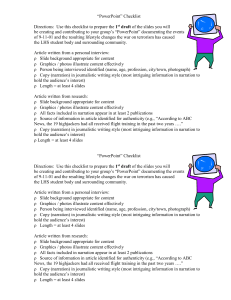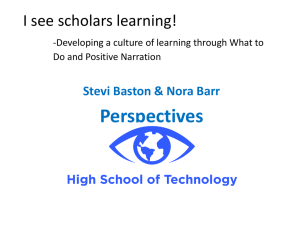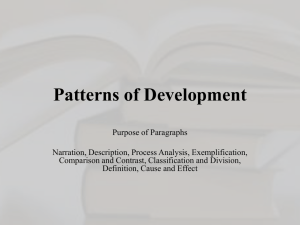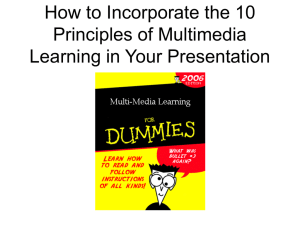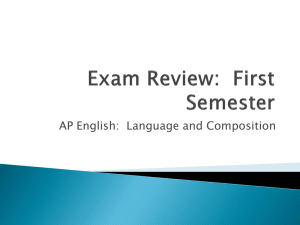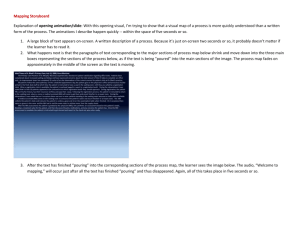Project Overview: This learning object is a form of courseware which
advertisement
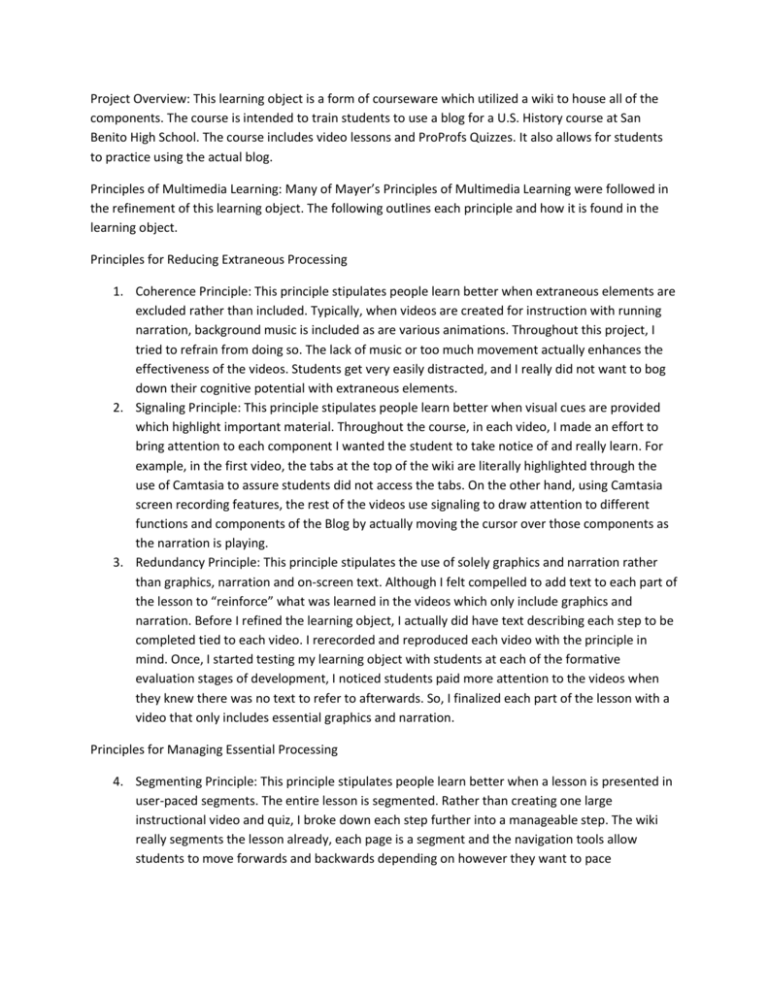
Project Overview: This learning object is a form of courseware which utilized a wiki to house all of the components. The course is intended to train students to use a blog for a U.S. History course at San Benito High School. The course includes video lessons and ProProfs Quizzes. It also allows for students to practice using the actual blog. Principles of Multimedia Learning: Many of Mayer’s Principles of Multimedia Learning were followed in the refinement of this learning object. The following outlines each principle and how it is found in the learning object. Principles for Reducing Extraneous Processing 1. Coherence Principle: This principle stipulates people learn better when extraneous elements are excluded rather than included. Typically, when videos are created for instruction with running narration, background music is included as are various animations. Throughout this project, I tried to refrain from doing so. The lack of music or too much movement actually enhances the effectiveness of the videos. Students get very easily distracted, and I really did not want to bog down their cognitive potential with extraneous elements. 2. Signaling Principle: This principle stipulates people learn better when visual cues are provided which highlight important material. Throughout the course, in each video, I made an effort to bring attention to each component I wanted the student to take notice of and really learn. For example, in the first video, the tabs at the top of the wiki are literally highlighted through the use of Camtasia to assure students did not access the tabs. On the other hand, using Camtasia screen recording features, the rest of the videos use signaling to draw attention to different functions and components of the Blog by actually moving the cursor over those components as the narration is playing. 3. Redundancy Principle: This principle stipulates the use of solely graphics and narration rather than graphics, narration and on-screen text. Although I felt compelled to add text to each part of the lesson to “reinforce” what was learned in the videos which only include graphics and narration. Before I refined the learning object, I actually did have text describing each step to be completed tied to each video. I rerecorded and reproduced each video with the principle in mind. Once, I started testing my learning object with students at each of the formative evaluation stages of development, I noticed students paid more attention to the videos when they knew there was no text to refer to afterwards. So, I finalized each part of the lesson with a video that only includes essential graphics and narration. Principles for Managing Essential Processing 4. Segmenting Principle: This principle stipulates people learn better when a lesson is presented in user-paced segments. The entire lesson is segmented. Rather than creating one large instructional video and quiz, I broke down each step further into a manageable step. The wiki really segments the lesson already, each page is a segment and the navigation tools allow students to move forwards and backwards depending on however they want to pace themselves through the lesson. Also, each video has a playback bar, so even within each video students can segment the chunks of information they are learning. 5. Modality Principle: This principle stipulates people learn better from graphics and narration than from animation and on-screen text. Not only did I avoid including text to avoid extraneous elements, I was also considering the modality of the object. Although reading instructions and following steps in written form may seem more logical and effective, this lesson proves otherwise. The use of the screen recordings of each step and the narration which guides users through those screen recorder steps allows students to visualize and internalize what they need to accomplish to a greater effect. This is why I decided to refrain from the text and strictly utilize narration and graphics. Principles for Fostering Generative Processing 6. Personalization Principle: This principle stipulates people learn better from multimedia lessons when words are in conversation style rather than formal style. Throughout the lesson, each video uses conversation style narration. The script often refers to the students or users as “you” rather than just reading out steps or facts with no personal reference. Also the tips provided by the avatar add a personalized element which addresses some questions or thoughts students might have while watching the videos. 7. Voice Principle: This principle stipulates people learn better when the narration in multimedia lessons is spoken in a friendly human voice. Considering the audience, i.e. high school students, an automated voice would probably not strike their interest. The voice provided was not overly friendly or too “cartoonish” to where the students would not deem it appropriate. As their teacher, I provided the voice for the narration. Many of these students will probably feel more at ease hearing a familiar voice rather than an automated voice which they have no prior experience learning through. Reflection My personal learning experience through the development of this learning object was one of always maintaining a willingness to make changes dependent on my newly acquired knowledge of the principles of multimedia learning and observations through formative evaluations. I learned many times an idea conceived might not always be the best or final way to achieve something. For instance, originally my plan was to create videos which provided screen captures of the processes being learned and provide the majority of the content textually. I really had based my conception of a web-based tutorial or learning object on my experiences in high school learning how to use different computer software programs. Usually we had a manual which textually specified the directions and provided some graphics. Usually those graphics were of people in office spaces using the program or working with a colleague. This conception I had in my mind of multimedia learning was obviously very poor by our current standards. Through my examination of the various principles, research online of the most current and cost-effective methods of learning and sharing, and running several field tests and formative evaluations, I was able to refine and really create a learning object which is relevant, effective, and useful to my school. I never really ran into any hurdles, but my willingness to change and evolve the scheme of my learning object from what I had developed in 6321 really helped me make peace with some major decisions for my project, i.e. the removal of heavy textual content.
